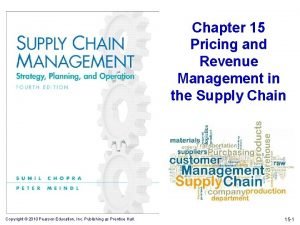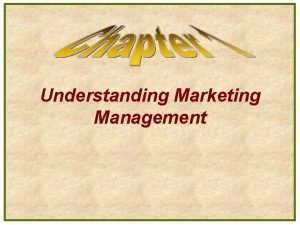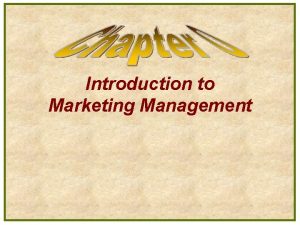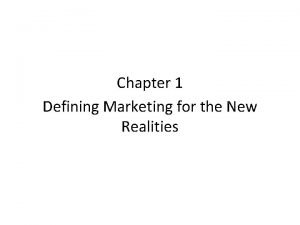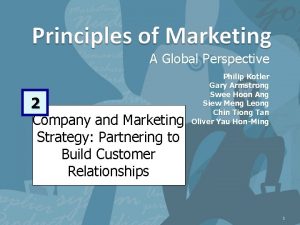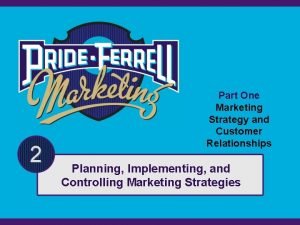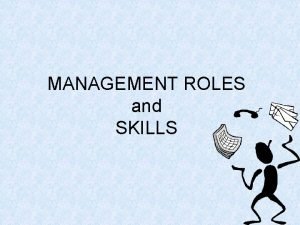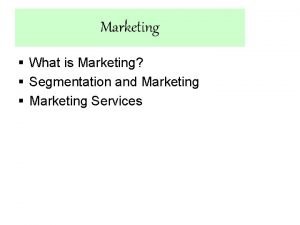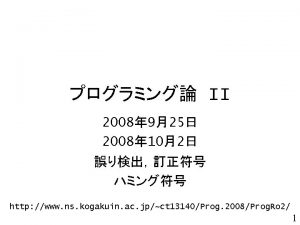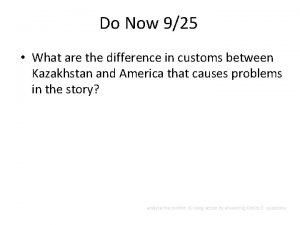The Role of Marketing and Marketing Management 925




































































- Slides: 68

The Role of Marketing and Marketing Management 9/25, 2018

The Scope of Marketing A product is anything that can be offered to a market to satisfy a want or need • Physical Products • Experiences • Persons • Properties • Information • Services • Events • Places • Organizations • Ideas



Times Square Theaters

Universal Studio— The Wizarding World of Harry Potter

Exchange and Transaction u Exchange is the act of obtaining a desired object from someone by offering something in return u Transaction refers to a trade between two parties that involves at least two things of value, agreed-upon conditions, a time of agreement, and a place of agreement

For-profit and Nonprofit Exchanges u For-profit exchanges are the goal of businesses that seek to generate revenues over and above their costs u Nonprofit organizations may sell products at a profit, then use the profits to cover the organization’s; they may also seek other goals such as blood donations, votes for political candidates, reduced smoking, recycled packaging, or volunteer time for needy children or the elderly.

Why Marketing? Capital Market Region Shareholder Value Organizational survival and growth Current and potential profits Competitors Product Market Region Attract and retain customers Customer Value Firm Competitors

Needs, Wants, and Demands u Needs describe basic human requirements u These needs become wants when they are directed to specific objects u Demands are wants for specific products backed by an ability to pay u Companies must measure not only how many people want their products but also how many would actually be willing and able to buy it

This Is a Needs - state of felt deprivation including physical, social, and individual needs.

Types of Needs u Physical: – Food, clothing, shelter, safety u Social: – Belonging, affection u Individual: – Learning, knowledge, self-expression

This Is a Wants - form that a human need takes, as shaped by culture and individual personality.

What Do We Want?

Marketing Myopia • The mistake of paying more attention to the specific products a company offers than to the benefits and experiences produced by these products

This Is Demand Wants Buying Power “Demand”

Need / Want Fulfillment u Needs and Wants Fulfilled through a Marketing Offer : – Some combination of products, services, information, or experiences offered to a market to satisfy a need or want.

Marketing Management Demand Management Demarketing Finding and increasing demand, also changing or reducing demand, such as in demarketing. Temporarily or permanently reducing the number of customers or shifting their demand.

Marketing: A Guiding Corporate Philosophy or A Function of Business? u As An Exchange Process – Marketing is the process of planning and executing the conception, pricing, promotion, and distribution of ideas, goods, services to create exchanges that satisfy individual and organizational goals (American Marketing Association) u As A Societal Process – Marketing activities facilitate the flow of products from producers to customers

Different Roles for Marketing u u The nature of the marketing function varies significantly from company to company Most small business don’t establish a formal marketing group at all. Their marketing ideas come from managers, the sales force, or an advertising agency. Such businesses equate marketing with selling. As companies become larger and more successful, executives recognize that there is more to marketing than setting the four P’s. They determine that effective marketing calls for people skilled in segmentation, targeting, and positioning. Once the marketing group tackles higher-level tasks like segmentation, it starts to work closely with other departments. The company starts to think in terms of developing brands, rather than products, and brand managers become powerful players in the organization. The marketers believe it’s essential to transform the organization into a “marketing-led” company.

The Evolution of Marketing u The Production Concept u The Product Concept u The Sales (Selling) Concept u The Marketing Concept u The Societal Marketing Concept

Marketing As An Organizational Process u The Marketing Concept – The organization exists to identify and to satisfy the needs of its customers – Satisfying customer needs is accomplished through an integrative effort throughout the organization – The organizational focus should be on long-term as opposed to short-term success u The Strategic Marketing Concept – The corporation’s mission is to seek a sustainable competitive advantage by meeting customer needs

Principles of Marketing Management u Customer Principle u Competitor Principle u Proactive Principle u Cross-Functional Principle u Continuous Improvement Principle u Stakeholder Principle u Synergy Principle

Synergy u. A system is a combination of component parts in dynamic interaction with one another; the joint effects of their combined parts are referred to as synergy. u Consistency Requirement + Compelmentarity Requirement Synergy u The 3 Ms: Management; Marketing; Marketplace

Principles of Consistency and Complementarity Purity cy n te s i s n Co Unscented Mild Complementarity White

Interactions Among the 3 Ms Firm SBUs Product Services Management Product Internal Environment Price Operating Environment Macro Environment Marketplace Promotion Distribution Marketing

Strategic Planning u Strategic planning involves adapting the firm to take advantage of opportunities in its constantly changing environment. u Strategic planning helps a firm to maintain a strategic fit between its goals and capabilities and its changing marketing opportunities. 2 -

Steps in Strategic Planning

Strategy as a Quest for Profit u The stakeholder approach : The firm as a coalition of interest groups: pursuit of multiple objectives. u The shareholder approach : The firm exists to maximize the wealth of its owners. u Why is profit maximization a reasonable goal? (1) Boards of directors legally obliged to pursue shareholder interests. (2) To replace assets, firm must earn return on capital > cost of capital (difficult when competition intense). (3) To survive acquisition, firm must achieve stock-market value > break-up value.

The Sources of Superior Profitability Industry Attractiveness Rate of Return Above the Cost of Capital How do we make money? Which industries should we be in? Competitive Advantage How should we compete? Corporate Strategy Business Strategy

Common Elements in Successful Strategies Successful Strategy Effective Implementation Long-term, Simple, and Agreed Objectives Profound. Understanding of the Competitive Environment Objective Appraisal of Resources

The Firm and Its Stakeholders Groups aremaintain affected by a The firmwho must firm’s performance and who performance at an adequate have wealth level claims in orderontoits retain the participation of key stakeholders

The Firm and Its Stakeholders Capital Market Stakeholders Shareholders Major suppliers of capital • Banks • Private lenders • Venture capitalists

The Firm and Its Stakeholders Capital Market Stakeholders Product Market Stakeholders Primary customers Suppliers Host communities Unions

The Firm and Its Stakeholders Capital Market Stakeholders Product Market Stakeholders Organizational Stakeholders Employees Managers Nonmanagers

Stakeholder Involvement Two issues affect the extent of stakeholder involvement in the firm Organizational Capital Market 1 How do you divide the returns to keep stakeholders involved? Product Market

Stakeholder Involvement Two issues affect the extent of stakeholder involvement in the firm Organizational Capital Market 2 How do you increase the returns so everyone has more to share? Product Market

Mission Statement u Statement of the organization’s purpose – What it wants to accomplish in the larger environment u Market oriented and defined in terms of satisfying basic customer needs u Emphasizes the company’s strengths u Focuses on customers and the customer experience the company seeks to create


Corporate-level Strategy u An organizational strategy that seeks to determine what businesses a company should be in or want to be in

Business-Level Strategy u The question “How do we compete? ” concerns business-level strategy u Business-level strategy pertains to each business unit or product line within the organization u It focuses on how the business unit competes within its industry for customers

Defining the Business Who is being satisfied? What is being satisfied? Customer needs Customer groups Definition of Business How are customer needs being satisfied? Distinctive Competencies

UC Berkeley vs. Stanford U.

Business Portfolio u Collection of businesses and products that make up the company u Steps in business portfolio planning: – Analyze the firm’s current business portfolio – Develop strategies for growth and downsizing to shape the future portfolio

Portfolio Analysis u Evaluation of the products and businesses that make up the company by the management u Steps: – Identifying the strategic business units (SBUs) – Assessing the attractiveness of its various SBUs and deciding the support each SBU deserves u The purpose is to direct resources toward more profitable businesses while phasing out or dropping weaker ones.

LVMH - Business Groups and Brands Wines & Spirits Moët & Chandon Dom Pérignon Krug Cheval des Andes Terrazas de los Andes Cape Mentelle The Glenmorangie Company Domaine Chandon Australia Hennessy Newton Veuve Clicquot 10 cane Belvedere Mercier Cloudy Bay Chopin Château d’Yquem Ruinart Bodegas Chandon Domaine Chandon California Fashion & Leather Goods Louis Vuitton Loewe Celine Kenzo Emilio Pucci Givenchy Marc Jacobs Fendi Berluti Thomas Pink Donna Karan e. LUXURY Stefano. Bi Perfumes & Cosmetics Parfums Christian Dior Guerlain Parfums Givenchy Perfumes Loewe Kenzo Parfums La Brosse et Dupont Benefit Cosmetics Fresh Make Up For Ever Acqua di Parma Watches & Jewelry TAG Heuer Zenith Dior Watches Chaumet Selective Retailing DFS Sephora Le Bon Marché Miami Cruiseline Services sephora. com Semaritaine Other Activities D. I group FRED De Beers LV Connaissance des Arts

The BCG Growth-Share Matrix

Growth-Share Matrix u Evaluates a company’s SBUs in terms of market growth rate and relative market share u Problems – Difficult, time consuming, and costly to implement – Difficult to define SBUs and measure market share and growth – Focuses on classifying current businesses but provide little advice for future planning

Assessing growth opportunities

Assessing growth opportunities u Intensive Growth u Integrative Growth u Diversification Growth u Downsizing and Divesting Older Businesses

Intensive growth u Corporate management should first review opportunities for improving existing businesses

INTEGRATIVE GROWTH u A business can increase sales and profits through backward, forward, or horizontal integration within its industry

Diversification growth u Diversification growth makes sense when good opportunities exist outside the present businesses –The industry is highly attractive and the company has the right mix of business strengths to succeed

Downsizing and Divesting Older Businesses u Companies must carefully prune, harvest, or divest tired old businesses to release needed resources for other uses and reduce costs

Marketing Planning Sequence Update historical data Collect current situation data Data analysis Develop objectives, strategies, programs Develop financial document Negotiate final plan Measure progress toward objectives Audit

Marketing Plan u u A marketing plan is a written document containing the guidelines for the business center’s marketing programs and allocations over the planning period The Objectives: – – To define the current situation facing the product To define problems and opportunities facing the business To establish objectives To define the strategies and programs necessary to achieve the objectives – To pinpoint responsibility for achieving product objectives – To encourage careful and disciplined thinking – To establish a customer-competitor orientation

Components of the Marketing Plan u u u u u Executive Summary Situation Analysis Summary of Opportunities and Problems Objectives Product/Brand Strategy Supporting Marketing Programs Financial Documents Monitors and Controls Contingency Plan

The Executive Summary u u It focuses on the objectives, strategies, and expected financial performance If the plan is being used as a business plan for a new product or service, the Executive Summary is crucial and should include other relevant information such as the business model, the amount of money needed from investors, how the money will be spent, key management, and a summary of the financial projections

Situation Analysis u Market Description – Category/Competitor Definition Category Analysis Customer Analysis Competitor Analysis u u Full description of new products, including all pertinent test data and comparisons with competition Planning assumptions

Summary of Opportunities and Problems u Key exploitable market opportunities u Key problems that should be addressed by this plan

Examples of a Company’s Strengths, Weaknesses, Opportunities, and Threats

SWOT Matrix

Objectives u u Quantitative and qualitative Corporate objectives (if appropriate) Divisional objectives (if appropriate) Marketing objective(s) – Volume and Profit – Time Frame – Secondary Objectives (e. g. , brand equity, customer Satisfaction) – Program (Marketing Mix)

The Product/Market Expansion Grid

Strategic Alternatives Long-term profits Growth in sales or market share Efficiency, short-run profits Market development Market penetration Decrease inputs New segments Existing customers Reduce costs Increase price Improve asset utilization Improve sales mix Convert nonusers Competitors’ customers New product development Increase outputs

Product/Brand Strategy u u Customer target(s) Competitor target(s) Product/service features Core strategy – Value proposition – Product positioning

Supporting Marketing Programs u u u u u Integrated marketing communications plan Advertising Promotion Sales Price Channels Customer management activities Website Marketing Research Partnerships/joint ventures

Financial Documents/ Monitors and Controls u Financial Documents – Budgets – Pro forma statements u Monitors and controls – Marketing Metrics – Secondary Data – Primary data
 Hg 925/1995
Hg 925/1995 A 925 n crate is being pulled
A 925 n crate is being pulled 925 million
925 million Azure web role vs worker role
Azure web role vs worker role Krappmann modell
Krappmann modell Role conflict occurs when fulfilling the role expectations
Role conflict occurs when fulfilling the role expectations Hát kết hợp bộ gõ cơ thể
Hát kết hợp bộ gõ cơ thể Ng-html
Ng-html Bổ thể
Bổ thể Tỉ lệ cơ thể trẻ em
Tỉ lệ cơ thể trẻ em Voi kéo gỗ như thế nào
Voi kéo gỗ như thế nào Glasgow thang điểm
Glasgow thang điểm Hát lên người ơi alleluia
Hát lên người ơi alleluia Môn thể thao bắt đầu bằng từ chạy
Môn thể thao bắt đầu bằng từ chạy Thế nào là hệ số cao nhất
Thế nào là hệ số cao nhất Các châu lục và đại dương trên thế giới
Các châu lục và đại dương trên thế giới Công thức tiính động năng
Công thức tiính động năng Trời xanh đây là của chúng ta thể thơ
Trời xanh đây là của chúng ta thể thơ Mật thư tọa độ 5x5
Mật thư tọa độ 5x5 101012 bằng
101012 bằng Phản ứng thế ankan
Phản ứng thế ankan Các châu lục và đại dương trên thế giới
Các châu lục và đại dương trên thế giới Thể thơ truyền thống
Thể thơ truyền thống Quá trình desamine hóa có thể tạo ra
Quá trình desamine hóa có thể tạo ra Một số thể thơ truyền thống
Một số thể thơ truyền thống Cái miệng nó xinh thế chỉ nói điều hay thôi
Cái miệng nó xinh thế chỉ nói điều hay thôi Vẽ hình chiếu vuông góc của vật thể sau
Vẽ hình chiếu vuông góc của vật thể sau Biện pháp chống mỏi cơ
Biện pháp chống mỏi cơ đặc điểm cơ thể của người tối cổ
đặc điểm cơ thể của người tối cổ Thế nào là giọng cùng tên
Thế nào là giọng cùng tên Vẽ hình chiếu đứng bằng cạnh của vật thể
Vẽ hình chiếu đứng bằng cạnh của vật thể Tia chieu sa te
Tia chieu sa te Thẻ vin
Thẻ vin đại từ thay thế
đại từ thay thế điện thế nghỉ
điện thế nghỉ Tư thế ngồi viết
Tư thế ngồi viết Diễn thế sinh thái là
Diễn thế sinh thái là Các loại đột biến cấu trúc nhiễm sắc thể
Các loại đột biến cấu trúc nhiễm sắc thể Bảng số nguyên tố
Bảng số nguyên tố Tư thế ngồi viết
Tư thế ngồi viết Lời thề hippocrates
Lời thề hippocrates Thiếu nhi thế giới liên hoan
Thiếu nhi thế giới liên hoan ưu thế lai là gì
ưu thế lai là gì Hươu thường đẻ mỗi lứa mấy con
Hươu thường đẻ mỗi lứa mấy con Khi nào hổ con có thể sống độc lập
Khi nào hổ con có thể sống độc lập Sơ đồ cơ thể người
Sơ đồ cơ thể người Từ ngữ thể hiện lòng nhân hậu
Từ ngữ thể hiện lòng nhân hậu Thế nào là mạng điện lắp đặt kiểu nổi
Thế nào là mạng điện lắp đặt kiểu nổi Role of pricing and revenue management in a supply chain
Role of pricing and revenue management in a supply chain Advanced corporate accounting ppt
Advanced corporate accounting ppt Pricing and revenue management in a supply chain
Pricing and revenue management in a supply chain Understanding marketing management
Understanding marketing management Marketing management objective
Marketing management objective Marketing meaning
Marketing meaning Defining marketing for the new realities ppt
Defining marketing for the new realities ppt Marketing research definition
Marketing research definition Role of imc in marketing process
Role of imc in marketing process Marketing's role
Marketing's role Role of research in marketing
Role of research in marketing Marketing's role
Marketing's role Classification of market research
Classification of market research Role of marketing in an organization
Role of marketing in an organization Role of marketing in an organization
Role of marketing in an organization The role of project management in achieving project success
The role of project management in achieving project success The role of management accounting in scorekeeping involves
The role of management accounting in scorekeeping involves Informational role of manager
Informational role of manager Role of managerial accounting
Role of managerial accounting Hr role in change management process
Hr role in change management process Operation manager function
Operation manager function
















































